

PUBLISHER
Sacha Wetzel
EDITOR IN CHIEF
Jason Jorgensen
DESIGN LEAD
Gustavo Bello
RESEARCH LEAD
Bhaskar Bhuyan



PUBLISHER
Sacha Wetzel
EDITOR IN CHIEF
Jason Jorgensen
DESIGN LEAD
Gustavo Bello
RESEARCH LEAD
Bhaskar Bhuyan
Quarter ends and the founder looks at progress and rallies enthusiasm to face the next that undoubtedly will be full of surprises and unavoidable realities as they ponder what they could of done better in the previous.
There is plenty of sniggers as they walk the halls of the latest conference and admiration seems short lived as a hammer in the back of the mind is already looking at the next target to calculate the odds of failure verses win.
When it’s time to sit at the table of the writer to construct needed publications around what is next and what's been completed they know a
conservative approach would be wise and it’s really what they would prefer to not feed the Statler and Waldorf naysayers more ammunition for ridicule.
Just as they put pen to paper, a voice reminds them, conservatives get quiet fund raising tables and less abilities to get this precarious concept over the line and so it’s a ramp up conservative pitch that starts the cycle again for the next quarter of crystal ball gazing and laughter from the cheap seats.
Good luck, may the sails of success be full for you all!
- Sacha

Congratulations! We have rounded the first corner on the track through 2024, and already we're seeing several interesting trends and developments in the aviation space, particularly in advanced air mobility (AAM).
Technological innovation was a strong focus, where companies like Joby Aviation, Wisk Aero, and Beta Air led in patent filings. This surge in intellectual property is indicative of the industry’s push towards refining propulsion and energy systems crucial for eVTOL vehicles, which are essential for extending the operational range and efficiency of these craft.
We are also seeing the stage being set for major public showcases to improve visibility and acceptance of eVTOL technology. A prominent example is the planned demonstration of air taxi services by Volocopter at the 2024 Summer Olympics in Paris. This event is expected to demonstrate the viability and safety of eVTOLs to a global audience, with multiple vertiports being constructed across Paris to facilitate this showcase.
Institutionally, there are proactive efforts by various authorities to integrate AAM into urban environments. The Greater Orlando Aviation Authority hosted its first AAM Industry Day, aimed at incorporating AAM into the region’s transportation framework. This event also reflects the growing alignment among regional planners, technologists, and policymakers in advancing AAM technologies and integration.
The regulatory landscape is also evolving, with the U.S. Department of Transportation soliciting input from the public and industry to shape a comprehensive national AAM strategy. This initiative aims to address the critical barriers and opportunities for AAM integration into the national airspace, marking a significant step that could facilitate wider adoption of AAM technologies.
Take a look at the following pages to see our most popular stories during the first quarter of 2024, and stay tuned to see how the stories continue to unfold into Q2 2024.
- Jason
AVFOIL NEWS CHRONICLES is published monthly by:
AVFOIL LIMITED
4 Mustang Lane, Wanaka Airport, Wanaka 9382, Otago, New Zealand news@avfoil.com • avfoil.com
Publisher: Sacha Wetzel - sacha@avfoil.com
EDITOR IN CHIEF: Jason Jorgensen - jason@avfoil.com
© Copyright 2024
AVFOIL NEWS CHRONICLES retains all rights for reproduction of any material submitted, to include but not limited to articles, photographs, emails and bulletin board posts. All material remains the copyright of AVFOIL NEWS CHRONICLES. No part of this publication may be reproduced, in part or whole, without the written consent of the publisher. Published content does not necessary reflect the views of the publisher. Content within AVFOIL NEWS CHRONICLES is believed to be true and accurate and the publisher does not assume responsibility for any errors or omissions. Unsolicited editorial manuscripts and photos are welcomed and encouraged. We cannot be responsible for return unless submissions are accompanied by a stamped, self-addressed envelope. Advertising deadline is 12 noon, on the 1st of the month preceding the month of publication.


Helicopter Columbia Helicopters
Aerial Fire Magazine
Fixed-Wing Press Release Bluedrop USA
Future Flight Chris Stonor eVTOL Insights
UAS / UAV Yves le Marquand Revolution.Aero
Sustainability Fayaz Hussain SAF Investor
Helicopter Press Release Bristow Group
Fixed-Wing Aerial Fire Staff

Aerial Fire Magazine
Future Flight Press Release Lilium
UAS / UAV Press Release Viasat
Sustainability Fayaz Hussain SAF Investor

Helicopter Press Release HELP Appeal
Fixed-Wing Mike Stones Corporate Jet Investor
Future Flight Chris Stonor eVTOL Insights




UAS / UAV Chris Stonor eVTOL Insights
Sustainability Fayaz Hussain

SAF Investor
Helicopter Press Release Axnes
Fixed-Wing Conair Group Aerial Fire Magazine
Future Flight Press Release Supernal
UAS / UAV Press Release SkeyDrone
Sustainability Press Release Volatus I&ES

EDITOR'S
Helicopter Press Release Smith Myers
Fixed-Wing Ryan Mason
Future Flight Chris Stonor
UAS / UAV Chris Stonor
Sustainability Fayaz Hussain
Aerial Fire Magazine
eVTOL Insights
eVTOL Insights
SAF Investor
David Balevic as President & CEO
Source: Aerial Fire News
Author: Columbia Helicopters Press Release


CThe Company’s principal customers include the U.S. military, foreign allied militaries, U.S. and foreign civil protection agencies, and a broad range of commercial customers.
Balevic brings more than 35 years of leadership experience across the aviation industry to Columbia. He previously spent eight years at CHC Helicopter, where he served as the Senior Vice President for Engineering & Operations before being promoted to President & CEO in August 2019.
During his tenure, Balevic oversaw all aspects of the business, including aircraft flight operations, supply chain, and the global MRO services. Additionally, Balevic has over two decades of experience at GE in their Aircraft Engine, Power, and Oil & Gas business units.
olumbia Helicopters announced on March 12th, 2024 that David Balevic has been appointed President & CEO, effective immediately. Balevic will succeed Michael Tremlett, who is departing the company to pursue other opportunities.
Columbia Helicopters is a global leader in the heavy and super heavy-lift helicopter sector, with a more than 60-year track record of innovation, technological firsts, and industry milestones.
The Company manufactures, provides sustainment services for, and operates the Model 234, CH-47D Chinook, and Model 107-II tandem-rotor helicopters.
“On behalf of the board we are excited to welcome David to Columbia Helicopters, and look forward to working with him as we drive continued growth across our three core businesses: Global Aerial Operations, MRO, and Aircraft Solutions,” said Kirk Konert, Member of the Columbia Helicopters Board. “Dave has the ideal combination of aviation experience and leadership expertise needed to lead the Company to its next phase of growth. We would also like to thank Michael for his contributions to our success and wish him well in the next stage of his career.”
“It is an honor to be given the opportunity to lead Columbia Helicopters and to continue to build upon its longstanding reputation for safety, quality, and customer satisfaction,” said David Balevic. “Given aviation industry tailwinds and our strategic advantages, the future for the organization looks bright and I am eager to get started working with the outstanding team we have in place.”
Source: Bristow Group Press Release
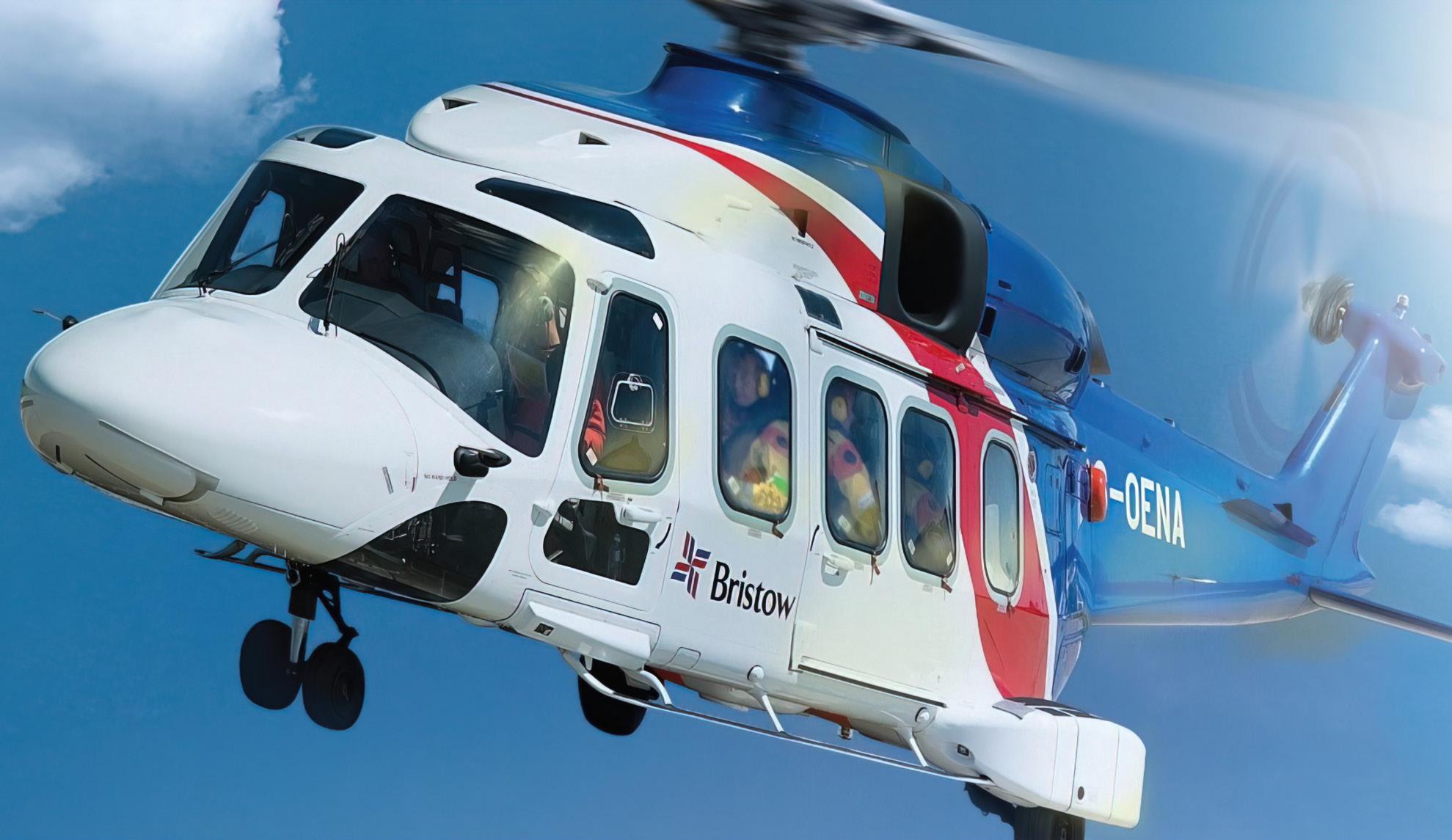

Bristow Ireland Limited, a subsidiary of Bristow Group Inc., has received its Air Operator Certificate (AOC) from the Irish Aviation Authority (IAA), marking a significant step towards the next generation of Coast Guard search-and-rescue aviation services in Ireland.
“Gaining an AOC is a fundamental requirement to provide search-and-rescue in Ireland,” said Neil Ebberson, Bristow director, Government Services.
“It was awarded after the successful completion of a lengthy application and assessment process run by the IAA and ensures the highest standards of professionalism and safety are met in the country.”
To gain AOC approval, Bristow Ireland was required to demonstrate that its Leonardo AW189 aircraft will meet the Irish regulator’s requirements for safe and compliant operations; submit detailed documentation to show that it can
safely manage continued airworthiness; demonstrate that it can safely operate the AW189 to the required standards; and carry out a proving flight with the AW189 in Ireland.
Ebberson added: “With more than 75-plus years of global experience to draw on, our Ireland team demonstrated that we have the experience, skills, and capabilities to operate to the standards the IAA demands for an Air Operator Certificate.
“The next phases of preparation for this critical new service are well in hand.
TOEXCEL Ireland Limited — who are our fixed wing partners — are working in parallel for the award of a fixed-wing AOC, which will in turn enable us to deliver the capability enhancements. We are looking forward to reporting more progress as we move towards the initial transition to the new service in late 2024.”
Bristow now has Air Operating Certificates covering 11 jurisdictions.
Helipad opens on the Isle of Mull, Scotland
Source: HELP Appeal Press Release

OnMarch 19, 2024, a new, lifesaving helipad opened on the Isle of Mull, Scotland, –adjacent to the Mull and Iona Community Hospital – after the HELP Appeal, the only charity in the country dedicated to funding hospital helipads, donated £418,000 to cover the entire cost of its construction and lighting installation.
The news comes hard on the heels of the announcement that a new HELP Appeal funded helipad is currently being constructed on the Isle of Gigha by the 39 Engineers Regiment of the Corps of Royal Engineers.
After the HELP Appeal confirmed to Mull and Iona Community Hospital and Mull and Iona Community Trust that it would fund the entire project, TSL Contractors, began constructing the helipad in May 2023 on land donated by Andy and Naomi Knight.
Mull and Iona Community Trust agreed to undertake responsibility from the outset to oversee the future condition and maintenance of the helipad.





The state-of-the-art helipad ensures that the Scottish Air Ambulance and larger HM Coastguard helicopters can land beside Mull and Iona Community Hospital any time of the day or night, which will avoid the need for a patient to be transferred by land ambulance to the Glenforsa airstrip, which is 15 minutes away by road.
This ensures that specialist hospital treatment at another A&E hospital or Major Trauma Centre on the mainland can be accessed within the Golden Hour and thus improve patients’ outcomes.
Scott’s story
Air ambulance patient, Scott Paterson knows the importance of an emergency helipad more than most. He was a driver in the Mull Rally, the U.K.’s only closed-road rally where over 150 cars race around single track roads at high speed. Unfortunately, Scott lost control of his car, which careened down an embankment, rolling over several times. After his injuries were assessed at Mull and Iona
Community Hospital, a decision was made to make an urgent transfer to the Queen Elizabeth University Hospital, Glasgow. Despite Scott having double compression fractures in his spine, he had to be transferred by road ambulance from the hospital to Glenforsa airstrip, which took 15 minutes over extremely bumpy terrain.
Paterson explains:
“If the helipad had been available at Mull and Iona Hospital at the time of my accident, I could have had a smooth and quick transfer to Glasgow. Although the ambulance staff were incredible and looked after me so well, the bumpy journey to Glenforsa was very uncomfortable and I was so worried not knowing how bad my injuries were at the time or if they could become life changing or life threatening. This helipad is going to help so many people like me whenever they need immediate access to a specialist trauma centre.”
The helipad has a lighting system with settings for different weather conditions, which are radio controlled by the incoming helicopter pilot, with a backup system at the nursing station in the hospital, enabling helicopter landings to take place around the clock.
Cheryl-Ann Paterson, NHS Highland’s Senior Charge Nurse for Mull & Iona, comments:
“We’re really grateful that the HELP Appeal has been so supportive by funding 100 percent of the cost of our new helipad. It is going to make such a difference to the health outcomes for our patients and the whole NHS Team across the island are united in their thanks.”
Robert Bertram, HELP Appeal’s Chief Executive, adds:
“This helipad is a game changer for the local community. When you’re seriously ill, delaying a departure from the island to access treatment at a Major Trauma Hospital or A&E hospital on the mainland could have serious consequences. This new helipad dramatically speeds up that access meaning that many more lives could be saved and demonstrates the HELP Appeal’s commitment to Scotland with another lifesaving helipad.”


Source: Axnes Press Release

Axnes AS, a provider of innovative wireless intercom communication systems, announced that it has been selected to deliver its cutting-edge PNG Wireless Intercom System (WICS) technology to the UK Ministry of Defence (MOD) for their Puma HC Mk2 Air System.
The PNG WICS will be utilized to enhance the aircrafts’ communication systems for search-andrescue (SAR) applications and human external cargo (HEC) missions. The Axnes PNG system allows the Puma to meet all (U.K./European standard requirements) for two-way radio communication for HEC operations.
The contract win entails the provision of a wireless radio communication system to connect and operate with the Puma HC Mk2 Air System Inter-Communication System (ICS). Each system will consist of a BST35 mobile base station, which wirelessly connects to a minimum of one deployable MP50 handheld transceiver, ensuring seamless communication with a range of at least 500 meters.
The Axnes PNG WICS, selected by the U.K. MOD, is designed to enable wireless communication in and around the Puma helicopters, specifically for rescue swimmers during SAR operations. The system is equipped with advanced features including full-

duplex, hands-free, VOX operation, which allows for easy communication even in extremely high noise environments. Its robust design ensures reliability and performance in the harshest and most challenging operational conditions.
“We are honored to have been awarded this prestigious contract by the U.K. Ministry of Defence,” said Morten Skrøvje, CEO of Axnes AS. “Our advanced wireless communication technology will greatly enhance the capabilities of the U.K. MOD Puma helicopters, enabling effective and efficient SAR operations. We are proud to contribute to the safety and success of search and rescue missions.”
The PNG WICS frees crew members from the encumbrance of wired connections to the intercom while minimizing the potential for ICS cord snag hazards. Additionally, this wireless solution provides the ability to move freely within as well as outside the aircraft while maintaining real-time communication with the crew.
The PNG WICS is designed for integration into any aircraft communications suite, or it can be deployed as a standalone portable system. PNG provides robust, reliable, clear, and secure, fullduplex communications to crew members who are either wired or wireless.
Source: Smith Myers Press Release
SmithMyers and AgustaWestland Aviation Services (AWAS) have formed a partnership to bring Smith Myers award-winning ARTEMIS mobile phone detection, location and communication systems to existing Leonardo’s helicopter users in the Middle East and North Africa (MENA) Regions.
Abu Dhabi-based AWAS provide a combination of engineering and maintenance expertise that will offer current Leonardo’s helicopter users a one-stop-shop for the procurement, integration, certification, commissioning, training and support of ARTEMIS onto existing Leonardo’s helicopter offering retrofit programs in the region.
“With over 200 Leonardo helicopters in service in the region and with AWAS involvement in comprehensive upgrade programs with major customers in the region, the partnership will provide Leonardo’s operators simplified access to this unique technology. We see the MENA region as a significant market for our airborne ARTEMIS suite of systems,” said Andrew Munro, managing director of Smith Myers.
Smith Myers ARTEMIS suite of search-andrescue (SAR) products has been saving lives around the world. Most recently selected for major United Kingdom, European and North American SAR and Coast Guard Programs.
The National Search and Rescue Centre (NSRC) of the United Arab Emirates (UAE) also selected ARTEMIS for installation across their fleet of SAR helicopters. ARTEMIS is also deployed around the world in maritime patrol, border control, aerial firefighting and natural disasters.
“This partnership will build on the success of the UAE National Search-and-Rescue Centre program, where AWAS installed the ARTEMIS systems onto the existing fleet of NSRC AW139s,” explained Angelo Vincenzo Carlino AWAS managing director, who added “We are excited to bring this transformational

technology to our customers.”

With nearly 1,200 Leonardo AW139s in service worldwide nearing 4 million flight hours for multiple roles with around 190 customers in over 80 countries, the bestselling intermediatetwin type has proven a major force also in the Middle East, with a number of aircraft dedicated to emergency medical service and SAR duties across the region.
The addition of the ARTEMIS system as a customer option would further enhance the impressive capabilities of the AW139 to carry out critical life-saving missions in this geography.
ARTEMIS has been designed to accurately locate mobile telephones in the challenging airborne environment using only two small antennas. ARTEMIS can detect a phone at extended ranges up to 35 kilometers and provides unique capabilities such as mass-mapping and geofencing to minimize crew workload.
The system is automated, quick and accurate. Leading to more rapid positive outcomes, even in low light/IMC conditions and operates standalone with no requirement for involvement of the Mobile Network Operators.

Dr. Brett Ulander appointed CEO of Bluedrop USA
Source: Bluedrop USA Press Release


confidence and support of the board of directors, and I look forward to working closely with our talented team to further advance our mission of delivering innovative training solutions that meet the evolving needs of our customers.”
Having served as the president of Bluedrop USA since 2020, Ulander has demonstrated exceptional strategic vision, operational expertise, and a deep commitment to the company’s mission. Under Ulander’s leadership, Bluedrop USA has achieved significant milestones and sustained growth, positioning the company as a key player in the defense and technology markets. His strategic insights and dedication to excellence have been instrumental in driving innovation, fostering strong customer relationships, and enhancing Bluedrop USA’s reputation for delivering cuttingedge solutions.
The board of directors of Bluedrop USA, a training and simulation company for the U.S. aerospace and defense market, has appointed Dr. Brett Ulander, president of Bluedrop USA, as president and chief executive officer, effective immediately. Bluedrop USA is the sister company of Bluedrop Training and Simulation, Inc. of Halifax, Nova Scotia, a leader in advanced training and simulation technologies.
“I am honored and excited to assume the role of CEO at Bluedrop USA,” said Brett Ulander. “I am grateful for the
In his new capacity as CEO, Ulander will continue to lead Bluedrop USA with a focus on driving innovation, expanding market presence, and delivering superior value to customers and stakeholders.
His proven track record of leadership and his deep understanding of the training and simulation market make him the ideal leader for Bluedrop USA’s next phase of growth.

Source: Aerial Fire Magazine
Author: Aerial Fire Staff
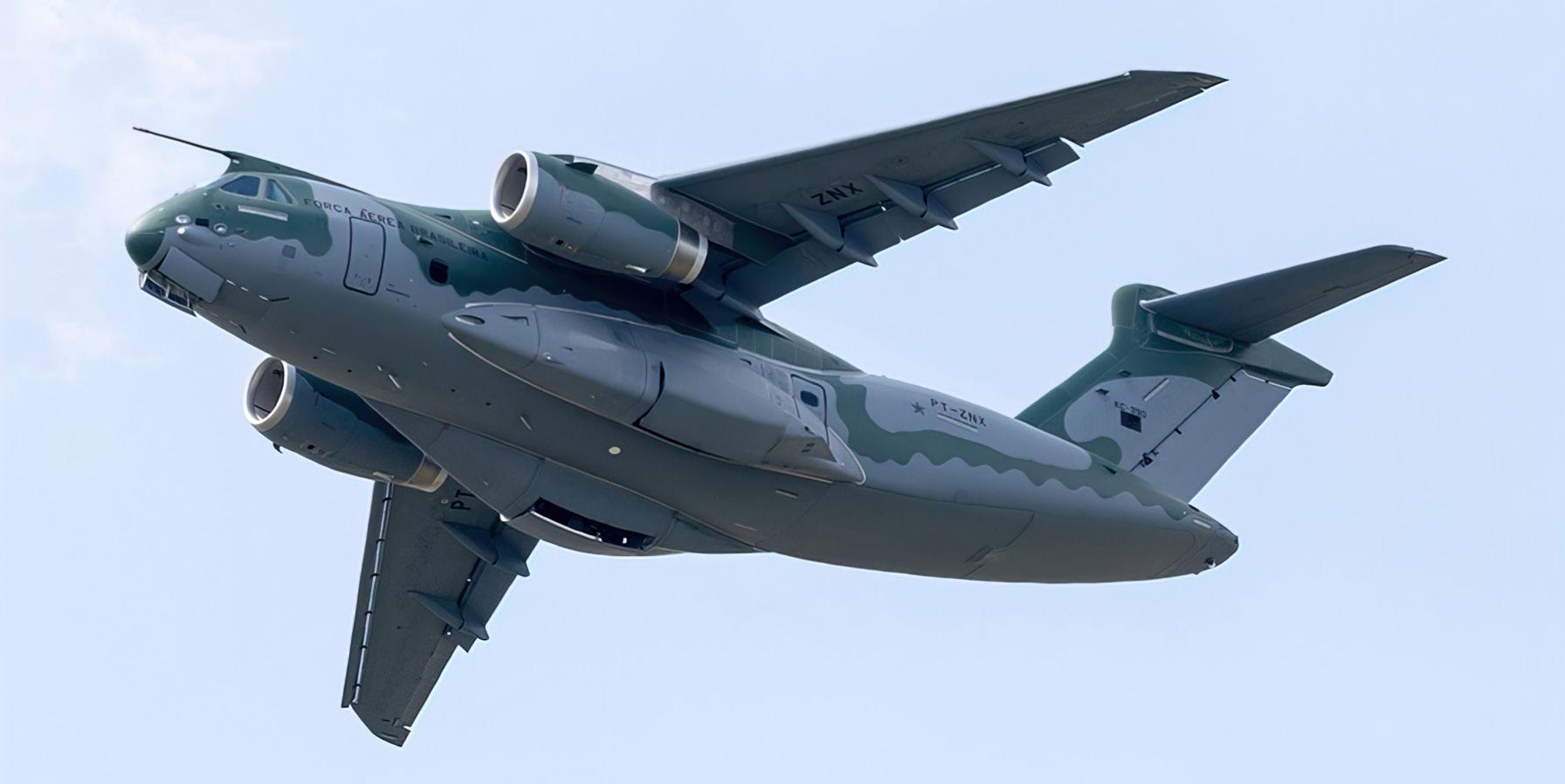
Brazil’s Embraer Defense and Security, along with Mahindra Aerospace, disclosed on Friday, February 9th, their agreement to explore the potential establishment of a regional hub for the medium transport aircraft C-390.
Additionally, the two companies are interested in securing the Indian Air Force (IAF) contract for Medium Transport Aircraft. The MoU was formalized at the Brazilian Embassy in New Delhi.
The collaboration surrounding the C-390 Millennium aims to introduce advanced aerospace and military transport technology to the Indian market. Embraer and Mahindra will collaborate with the Indian Air Force to determine the subsequent stages of the MTA program and engage with the local aerospace industry in India to commence developing the industrialization plan for the project, according to a joint statement.
The MoU was signed by Embraer Defense & Security and Mahindra Defence Systems Limited , a wholly-owned subsidiary of Mahindra specializing in

armored transport and security-related electronics.
João Bosco Costa Junior, President & CEO of Embraer Defense & Security, stated, “We are pleased to announce this MoU with Mahindra. India possesses a robust and diverse defense and aerospace sector, and we have selected Mahindra as our partner to jointly pursue the MTA program.”
“India is a significant market for Embraer, and we fully support India’s aspirations for ‘Atmanirbhar Bharat.’ We view this collaboration as a means of strengthening ties between Brazil and India and fostering cooperation among nations of the Global South,” he added.
To date, the C-390 Millennium has been chosen by Brazil, Portugal, Hungary, the Netherlands, Austria, the Czech Republic, and most recently, South Korea. The C-390 is aimed at markets in various missions, including cargo and troop transport, medical evacuation, search and rescue operations, aerial firefighting, and humanitarian missions.
Source: Corporate Jet Investor
Author:
Mike Stones

Comlux has delivered its second ACJ TwoTwenty cabin from its completion centre in Indianapolis; eight months after finishing the first project. The delivery is part of Comlux’s exclusive 15-aircraft partnership with the business jet manufacturer. Outfitting a third cabin is underway and is expected to be completed by the end of this year.
Speaking on Monday (February 19th), Richard Gaona, executive chairman and CEO, Comlux said: “The fourth ACJ TwoTwenty is arriving to Comlux Completion as a green aircraft in a few days, and we will be commencing its cabin outfitting as soon as it reaches our facilities. From 2025 onwards, we are targeting to deliver four to six ACJ TwoTwenty cabins per year.”
The latest ACJ TwoTwenty completion will be operated by the company’s charter and operatons business Comlux Aviation.
Chadi Saade, president, Airbus Corporate Jets, congratulated its partner Comlux for “the fabulous work” achieved on this second cabin. “The best keeps getting better,” he said. Saade went on to say the ACJ TwoTwenty





is “a game changer” on the extra large business jet market, connecting business and communities across the world, bringing what he claimed is best in class comfort, efficiency and intercontinental range.
Also this week, Comlux revealed a new partnership with Pratt & Whitney to provide engine maintenance for the GTF PW1500G engines powering the ACJ TwoTwenty. Andrea Zanetto, CEO, Comlux Aviation said: “In private aviation, customers like to have a full support package for their aircraft operation. Airbus is offering such option for the airframe, Comlux for the cabin, and this collaboration with Pratt & Whitney is the complement we need to make all customers comfortable when buying the ACJ TwoTwenty.”
Nick Tomassetti, vice president, Sales & Marketing, Pratt & Whitney claimed the engines offered unmatched fuel efficiency and range, plus a 75% reduction in noise footprint. “We are supporting Comlux and its customers with engine maintenance services for the ACJ TwoTwenty, a unique aircraft offering in the business jet landscape,” he said.


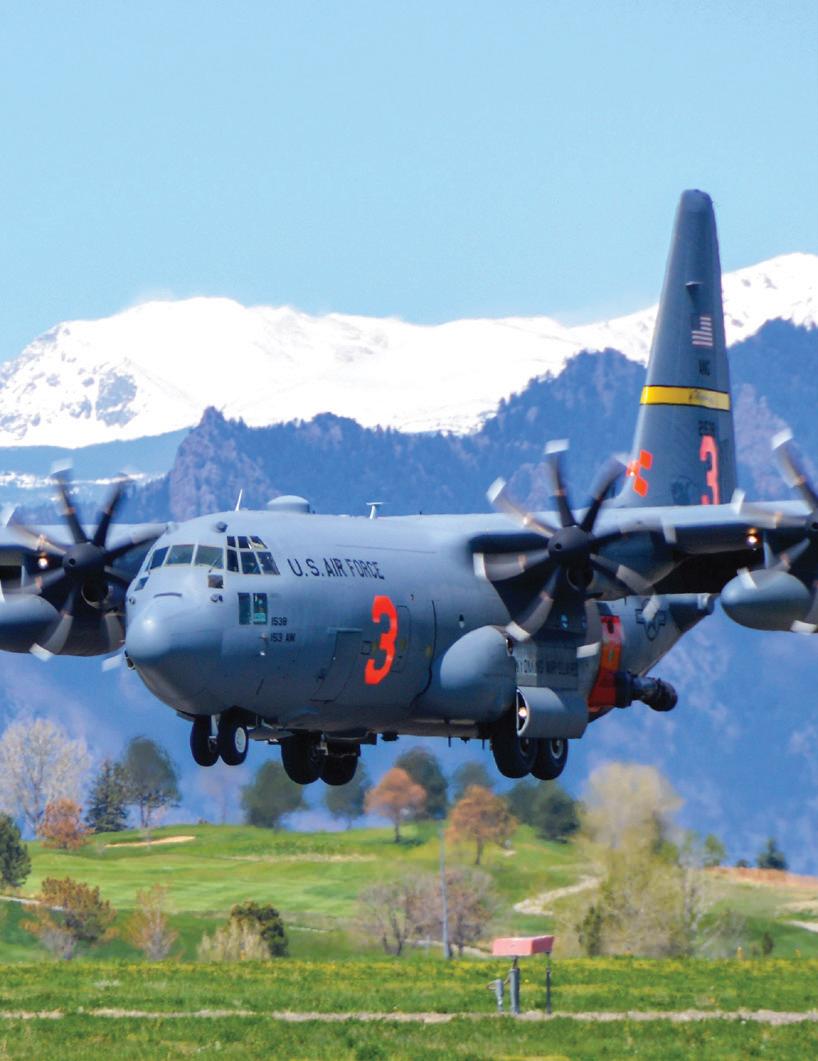

Source: Aerial Fire Magazine
Author: Conair Group Press Release
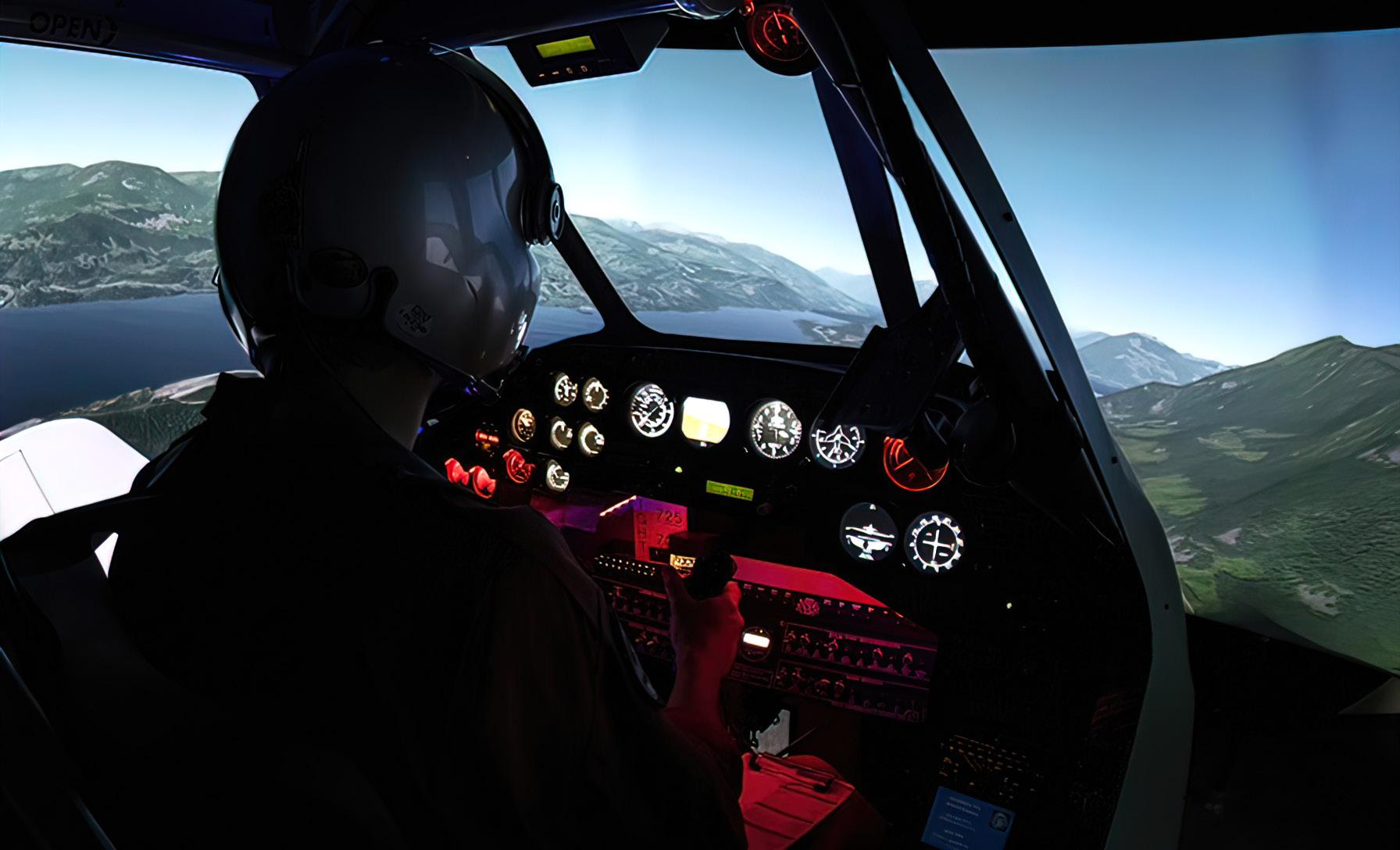
Conair Group Inc. is excited to announce the six Flight Training Devices (FTDs) in its Mission Training System (MTS) platform are now certified to Level 4 by Transport Canada. The six FTDs are federated devices which allow aerial firefighting pilots the ability to train over the same wildfire at the same time, practicing in coordination to produce more effective, and safer, missions.
“This certification is incredibly important as it means the MTS is the first training system in the world to be certified for aerial firefighting” shares Scott Stewart, Manager, Flight Standards with Conair. ”Our pilots can now gain credit for training in the MTS, reducing the total time required in the actual aircraft. Not only can we train our pilots more effectively, in multi group simulator sessions, we can train them more efficiently, giving them significantly more experience over fires to prepare for real-world operations from within the safe confines of a simulator platform. Additional specific approvals, including low visibility and night training, allow us to train crews for the challenges of aerial firefighting in a much more realistic and meaningful manner."

The Level 4 certification has been granted for the Dash 8-400AT, RJ85, Cessna 208B, TC690, and two AT802, wheeled/floats, FTDs.
“The aerial response to wildfires is complex. Often there are multiple aircraft over a fire, challenged by smoke, turbulence, terrain, and heat. Training together in an environment that mimics real life, including complex radio communications, is beneficial for our crews,” says Mark Baird, Large Airtanker Fleet Manager. “It means when they step into the field on deployment day, they are ready to execute. We can offer hours of additional training to our pilots, plus we can practice maneuvers and emergency exercises in a safe environment, something you can’t practice during on-wing training.
And we can use the simulators to qualify more pilots faster, keeping up with the rising demand.”
“This spring we are training Conair pilots, plus Aero-Flite crew, our US subsidiary company, and we are welcoming our first third party customer” shares Scott. “Another benefit
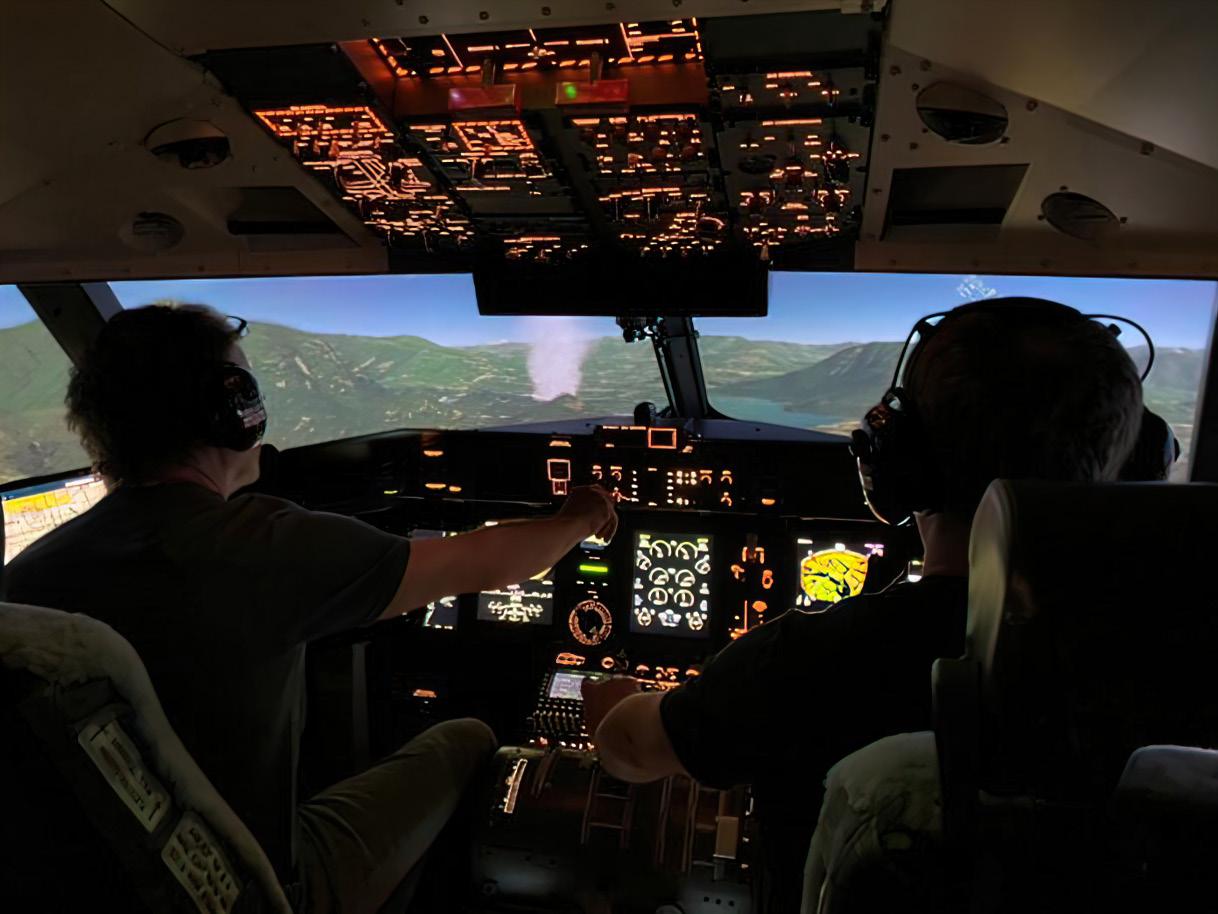
to the MTS is our ability to partner with our government agency customers, helping to train Air Attack Officers who strategize the aerial response and coordinate tactics over the fire. The ability to train and practice before a fire season starts offers incredible benefits. Ground school is put into practice before the first challenging wildfire of the season emerges. Such highly realistic training helps ensure aerial firefighters are current and ready to respond effectively the moment there is a need.”
First envisioned in 2017, the MTS is the only one in the world of its kind and made possible using Conair’s experience in aerial firefighting. In 2021 Conair completed the MTS as proof of concept,
linking three FTDs locally. Conair leveraged lessons learned from the platform and

launched an expanded MTS program in 2022, incorporating two large airtankers (Dash 8-400AT and RJ85) with a TC690 bird dog. Building off that success, the final three FTDs were installed in 2023.
The platform offers extremely high-resolution graphics with a 200 degree by 45 degree field of view. Pilots are able to see and hear each other during the simulation, with fire behavior reacting to drops, taking into account humidity, weather, fuel type, and terrain, producing visually accurate representations, including smoke.
The MTS within Conair’s Training + Tactic Centre is currently available for pilots at Conair and Aero- Flite, in addition to partner government wildfire management staff. There are plans to expand the program globally in the future.

Source: Aerial FIre Magazine
Author: Ryan Mason
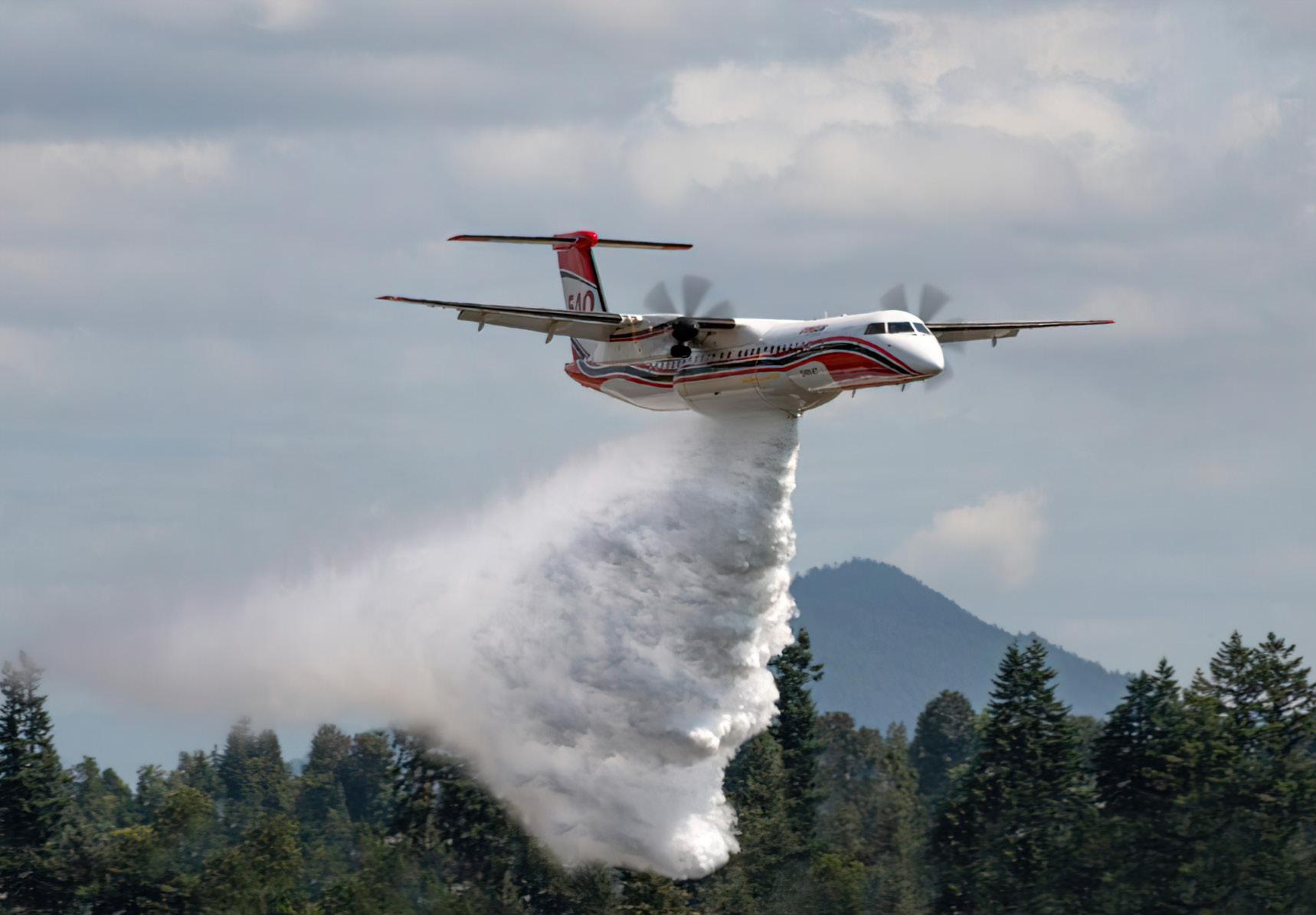

After nine seasons in Victoria, the RJ85 has passed the “B391” baton onto Conair Aerial Firefighting’s Dash 8-400AT C-FFQF. This airtanker is now on standby at Melbourne Avalon Airport. Tanker 391 began it’s journey to Australia in late November, leaving behind frosty weather in Abbotsford Canada, travelling through Oakland, Honolulu, the Solomon Islands before arriving on the continent.
The tanker operated out of Bordeaux from July to September, supporting the Government of France during the 2023 fire season. It completed it’s heavy maintenance during the fall from Conair’s hangars before migrating south. This tanker began operations in 2021, operating its first season in Alaska.
Dash 8-400AT B391 will be joined in Avalon by the permanently Australian-based Dash
8-400AT C-FFQE “B390”, which completed its seasonal contract in Queensland as B141 in December. The Dash 8-400AT B141 airtanker had been based in Bundaberg from September to December, supporting firefighters in the region.
Also working in Australia this 2023/2024 bushfire season from October to February for Conair/Field Air is Bomber B164, an RJ85 based in Dubbo, New South Wales. It deployed to Busselton in Western Australia in November when duty called, a shared resource between wildfire agencies.
The large airtanker and crews were proud to support communities in need as a reinforcement during a period of increased fire threat when Western Australia’s LAT was grounded for a period of time.

Source: eVTOL Insights
Author: Chris Stonor
Whisper Aero, a U.S-based cutting-edge, next generation electric propulsion company, announced recently it has chosen the First Resonance ION Factory OS System to assist in building its “ultra-quiet propulsor” production, reports airframer.com. As the company’s website states, “The future needs to be as considerate as it is compelling.” (Robert Downey Jr.)
The ION Factory OS System is able to “capture everything that happens on the factory floor, including processes, parts, inspections and red lines. This will significantly reduce the time it takes to comply with the rigorous audits required for certification,” explains the article. This ease of execution supports Whisper’s “ramp up in production” and is “anticipated to significantly reduce cycle times with each propulsor produced.”
Whisper is setting up its first manufacturing line at the company’s Tennessee headquarters. The choice of ION’s real-time analytics and inspection control checkpoints is influenced by several key factors, including: -
- Advanced traceability features.
- Support for AS9100 certification.
- The system’s ease of deployment and maintenance.
Ian Villa, COO and CPO at Whisper Aero, explained, “As we gear up our new Tennessee facility, our goal is to begin producing propulsors before the end of this year. After evaluating multiple vendors, ION by First Resonance emerged as the sole solution capable of meeting our aggressive timelines and extensive requirements.”
Throughout the initial testing and production phases, Whisper is “to leverage ION’s as-built Bill of Materials capabilities to automate
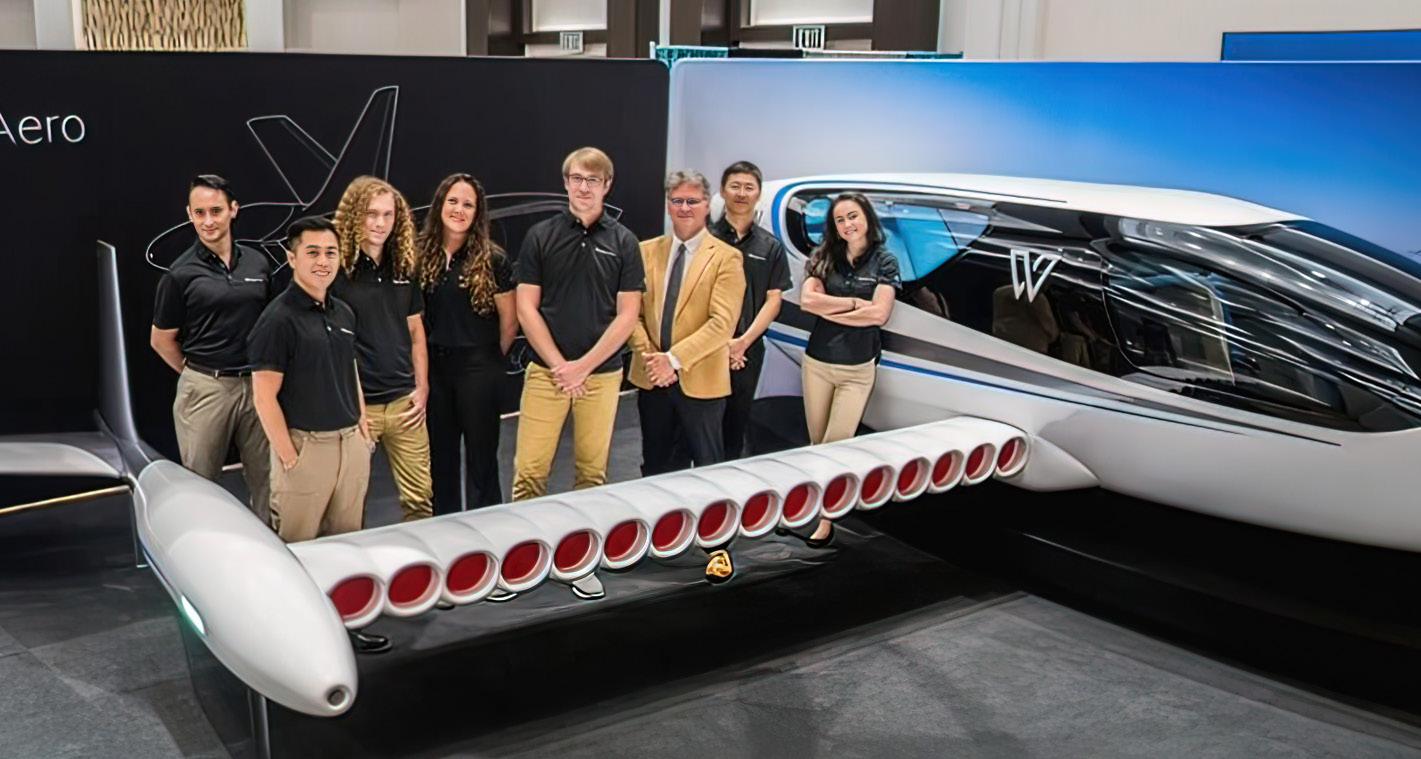

data capture related to material, process, and procedure changes. Post-production, ION Factory OS will continue to play a vital role in maintaining comprehensive traceability, overseeing serial numbers and managing sign-offs,” continues the article.
As a company engaged in DOD contracts, stringent data security and achieving AS9100 certification is imperative. The article points out, “ION Factory OS aligns seamlessly with these priorities by streamlining the audit process required for certification.”
In a competitive landscape where speed to market is paramount, Whisper Aero’s choice reflects the company’s urgency to establish its factory. First Resonance’s ready-todeploy system, allows it to focus on building groundbreaking propulsors without the need for extensive software customisation.
Villa continues, “We chose ION because the system is ready to go right away, where the team has deep experience in aerospace, so they know exactly what we need.”
Karan Talati, CEO and co-Founder of First Resonance, brings engineering expertise from SpaceX, having experienced firsthand the challenges of pioneering advancements. He remarked, “We are privileged to join Whisper Aero’s journey and ushering in a new era of environmentally-friendly air travel in the aerospace industry.”
Source: Lilium Press Release

Lilium announced this week it is preparing the installation of its propulsion units for its prototype Jet, reports a press release. They will begin coming off the assembly line in Q2, to be used for testing.
Lilium is collaborating with Schnaithmann Maschinenbau, the German automation and robotics company which is also supporting the company with workflow design, jigs and tools for Lilium’s aerostructures for the final assembly line. Located near the automotive hub of Stuttgart, Schnaithmann is a global leader in designing and supplying automated, scalable industrial solutions with long-standing partnerships in high-volume industries, especially automotive.
This partnership started several years ago. Lilium’s aerostructures assembly line is already utilising equipment provided by Schnaithmann for handling of the Jet’s wings and canards. The propulsion assembly line is located in the same building as Lilium’s aerostructures.
Jan Dr Nowacki, Lilium Senior VP of Manufacturing, commented, “The electric jet engine is a unique, core technology, critical for aircraft performance. With the support of Schnaithmann, we look forward to implementing state-of-the-art manufacturing solutions capable of being scaledup and replicated for high-volume production.”
Gerd Maier, Schnaithmann Member of the Management Board, Sales and Marketing , added, “With nearly 40 years of experience in supplying automation technology to global industries, we are proud to participate in the industrialisation of the Lilium Jet. The eVTOL industry has the potential to change aviation in a positive, sustainable way, and we are


delighted to be able to play a key role in helping Lilium scale up towards high-volume production.”
The release explains, “The electric jet propulsion unit is a core company technology and key to providing the required performance, unit economics and comfort for regional air mobility. Consisting of electric jet engines integrated into the propulsion mounting system that forms the rear part of the wings and front aerofoils, the Lilium Jet’s unique propulsion system will provide advantages in payload, aerodynamic efficiency and a reduced noise profile, while also providing thrust vector control to maneuver the Lilium Jet through every phase of flight.”
In 2023, following successful testing of engine systems, including the fan, stator and e-motor, Lilium assembled the first complete Jet electric engine on a pre-series line. The e-motor has been designed to deliver industry-leading power density of over 100kW from a system weighing just over 4kg. Major subassemblies of the propulsion unit are delivered to Lilium by a team of qualified suppliers including Honeywell in alliance with Denso (e-motor), Aeronamic (fan), and SKF (electric motor bearings).
Meanwhile, Lilium will be releasing its Full Year and Fourth Quarter 2023 Shareholder Letter on Tuesday (February 27th). The company is hosting a conference call at 8 am EST. To access the webcast of the call, please visit the Lilium investor relations website at: Lilium FY 2023 Business Update | Lilium N.V.
Source: eVTOL Insights
Author: Chris Stonor

Elfly, a developer of an all-electric seaplane called Noemi announced recently it has moved into new facilities at Torp Sandefjord Airport in southern Norway, reports a press release.
The expanding company has taken a 1,160 square metre office and workshop space in the airport’s large hangar, where it plans to build the first full-scale Noemi seaplane. The new location offers plenty of space to expand as its program ramps up. Testing and validations will also be undertaken here.
Neighbours include the Norwegian Air Ambulance and its increasing fleet of emergency medical services H135 and H145 helicopters; several flying schools and training establishments; as well as regional airline Wideroe’s Dash 8-Q400 maintenance facility.
Torp Airport is owned by the municipality of Sandefjord and Vestfold county, alongside Vestfold Flyplassinvest AS. It is the largest privately-owned airport in Norway, positioned 110 km southwest of Oslo, with a full-scale NATO standard runway. The airport enjoys international and national scheduled air services from Wideroe, Ryanair, Air Baltic, Norwegian and





Wizz Air, along with various charter flights.
Eric Lithun, Founder and CEO of Elfly, commented, “Torp Airport is an excellent new location for us to build on and engineer. It affords us plenty of space to grow for testing, while ramping up our team.”
He continued, “Moreover, the airport’s dynamic management are enthused by our plans to return seaplane travel to the fjords and lakes of Norway by using electric power.” The company will retain, for now, its present business unit in Bergen.
Gisle Skansen, CEO of TORP Sandefjord Airport, added, “We are thrilled of the news that Elfly has chosen our airport as their hub for developing next generation seaplanes. TORP is encouraging the company to introduce zero-emission aircraft and contribute towards more sustainable and environmentally friendly aviation. We look forward to following their progress very closely as a valued new tenant.”
Elfly is developing a full-scale prototype of its Noemi in collaboration with the Norwegian Government, with funding newly secured
from Enova SF. Construction is on schedule to commence this summer. The goal is to fly the first prototype in 2026.
In preparation, Elfly’s team has swelled to 30 staff with senior engineers recently joining from Airbus, Pilatus Aircraft, HondaJet, Dornier Seawings and Heart Aerospace.
Background
The Elfly Group was founded in 2018 and established in Bergen, Norway. Its leading program is a modern-day amphibious aircraft with batteries and two electric engines, inspired by the de Havilland Twin Otter and Grumman’s Mallard.
The Noemi seaplane is designed for 200 km air journeys and is to be powered by two electric motors with up to 1MW combined output. Its design is part of a research project, funded by private investors and the Research Council of Norway.
Elfly is working to obtain certification for its prototype to CS23 Level 4, which enables the aircraft to evolve up to a 19-seat seaplane. Initially, it will be offered as a business/ executive cabin with nine seats, plus luggage, complemented by a VIP layout with six seats. A tourist pleasure flight model with 13 seats, minus baggage, as well as cargo and medieval versions are also planned.
For more information
www.el-fly.no



Supernal LLC, Hyundai Motor Group's Advanced Air Mobility (AAM) company, has announced the appointment of David D. McBride as Chief Technology Officer (CTO). McBride, a seasoned aerospace expert with over 40 years of experience, will spearhead Supernal's technology strategy and vehicle development, reporting directly to CEO Jaiwon Shin.
Jaiwon Shin expressed excitement about McBride's appointment, highlighting Supernal's transition into a new phase of Advanced Air Mobility business. With McBride's extensive expertise, Supernal aims to transform innovative vehicle concepts into commercially viable and safe allelectric aircraft by 2028.
McBride's illustrious career at NASA - National Aeronautics and Space Administration, where he served as the director of the NASA’s Armstrong Flight Research Center, underscores his capability to lead groundbreaking aerospace initiatives. His achievements include achieving full operational capability of the Boeing 747SP aircraft for stratospheric observation and leading the development of NASA's all-electric aircraft.

As CTO of Supernal, McBride will oversee the company's Engineering and Technology Division (ETD), comprising 400 employees dedicated to vehicle engineering, testing, evaluation, certification, and research and development (R&D).
McBride expressed his enthusiasm for joining Supernal and contributing to the certification and commercialization of the company's aircraft. With a focus on transitioning from engineering design to execution phases, McBride emphasized Supernal's impressive team and the anticipation of their first flight later this year.
With a bachelor's degree in electrical engineering and an executive master's degree in business administration from The University of New Mexico, McBride's journey from a cooperative education student to a leader in aerospace technology exemplifies his dedication and expertise in the field.
Follow our blog for comprehensive coverage of Supernal's advancements in Advanced Air Mobility and the contributions of David McBride towards shaping the future of aviation.

Swiss
Source: eVTOL Insights
Author: Chris Stonor

Lookinga little similar to a Lilium Jet, Swiss startup, SIRIUS AVIATION AG, has unveiled what it describes as “the world’s first liquid hydrogen VTOL aircraft” with an ambitious plan to have it in the air by 2025, reports freethink.com.
What makes Sirius different to its rivals is that instead of electricity as the energy source, this jet uses liquid hydrogen allowing for a much longer flight distance. The company claims its aircraft could fly from New York City to Miami without a refuel.
The jet’s propulsion system combines this hydrogen with oxygen, pulled in from the outside air, to generate the electricity needed to power it. The only byproduct of this process is water.
Sirius has unveiled two versions of its hydrogen VTOL: The Sirius Millennium Jet and the Sirius Business Jet. The aircraft has been designed in collaboration with Designworks, A BMW Group Company, and Sauber Group, an engineering company known for its Formula 1 cars.
The Millennium has room for five passengers and a pilot, and its flight range of 650 miles is more than enough to fly from Washington, DC to Chicago. The Sirius Business Jet, meanwhile, has room for three passengers and a pilot

and a range of 1,150 miles, enough for a trip between New York and Miami. Both have a cruise speed of 320 mph. Compare this to Joby Aviation’s eVTOL with a range of 150 miles and a top speed of 200 mph or Archer Midnight’s 100 miles and 150 mph.
While the Federal Aviation Administration has already certified one hydrogen plane already as “airworthy” — the Universal Hydrogen’s Dash-800 — as Sirius’ hydrogen VTOL is the first of its kind, there’s no precedent for certification. This means the process could take some time to achieve. For liquid hydrogen is a novel fuel source for aircraft. Most indevelopment hydrogen planes store the fuel in a gaseous form. The first piloted flight of a craft fuelled by liquid hydrogen only took place last September.
Even so, Sirius has laid out an ambitious timeline for its jets, with the first test flights planned for 2025, followed by certification in 2026 and the launch of commercial services by 2028.
As with any startup, sufficient funding will be the primary obstacle to overcome. Up to now, investment has come internally. Alexey Popov, CEO of Sirius, told Aviation Week Network, “We have funds, but not enough as the market is hot and we need to move fast.”

Autonomy programme contract
Source: Revolution.Aero
Author: Yves le Marquand

Xwing has won a small business innovation research (SBIR) contract from the US Army xTech SBIR Autonomy programme.
The contract will see Xwing conduct autonomous airlift and logistics missions during live military operational demonstrations. Other SBIR contract awardees include: Elroy Air, Censys Technologies and Steer Tech.
Nicole Fox, SBIR Program’s portfolio manager for autonomy and contested logistics, sustainment, science and technology said: “To support mobility and navigation across multiple terrains, it’s important we develop and employ ground and aerial robotic autonomous systems throughout the Army. Solutions developed via the competition – and through follow-on SBIR contracts – will support Soldier safety and efficiency in contested environments.”

Last month, Xwing was awarded a Military Approval to fly autonomous cargo missions during the Air Force’s AGILE FLAG 24-1. As part of this Agile Combat Employment (ACE) exercise, Xwing flew over 2,800 autonomous flight miles through public and military airspace, delivering cargo to eight different military and civilian airports across California.
Kevin Antcliff, Xwing’s head of Product said: “Xwing is at the forefront of uncrewed aviation, focusing nearterm on transforming operations in scenarios typically described by the three Ds of robotics: dull, dirty, and dangerous. This innovation is crucial for reducing dependency on manned aircraft confronted with these threats. By shifting to uncrewed aircraft, we aim to enhance safety, efficiency, and operational flexibility across various mission types.”
Viasat welcomes video streaming specialists Videosoft Global to Velaris Partner Network
Source: Viasat Press Release
Viasat, Inc., a global communications company, is welcoming Videosoft Global –which provides adaptive encoding and secure real-time video transmission over wireless networks – to its Velaris Partner Network.
The partnership will enable enhanced realtime video streaming capabilities over satellite communications, providing peace of mind to ground crews even in areas of poor terrestrial coverage, or tough network environments. This brings enhanced situational awareness to some of the most challenging environments on the planet.
One such use of the technology is in search and rescue scenarios – where uncrewed aerial vehicles (UAVs) can be at the scene much more quickly than human crews, without compromising on safety, and stream video back to a control room without the need for ground-based communications infrastructure.
Additionally, the technology could be used to provide real-time onboard monitoring of passengers to enhance comfort and safety. This system communicates with ground-based control centers and vertiports, catering to the future air taxi market.
More than simply bringing eyes and ears to uncrewed platforms, Videosoft Global’s technology also provides high-quality video with much lower data costs. Streaming live video usually demands significant bandwidth usage, which can result in high data costs. This is where Videosoft’s technology excels, using adaptive video compression and transmission to address these issues. By enabling streaming from as little as 4kbps, it not only cuts down data usage significantly but also broadens operational coverage.
Increasing ease of use and speed of integration for aviation operators, Videosoft Global’s ‘plug and play’ software will run natively on Viasat’s low size, weight, and power Velaris satcom terminal, developed in partnership with Gotonomi
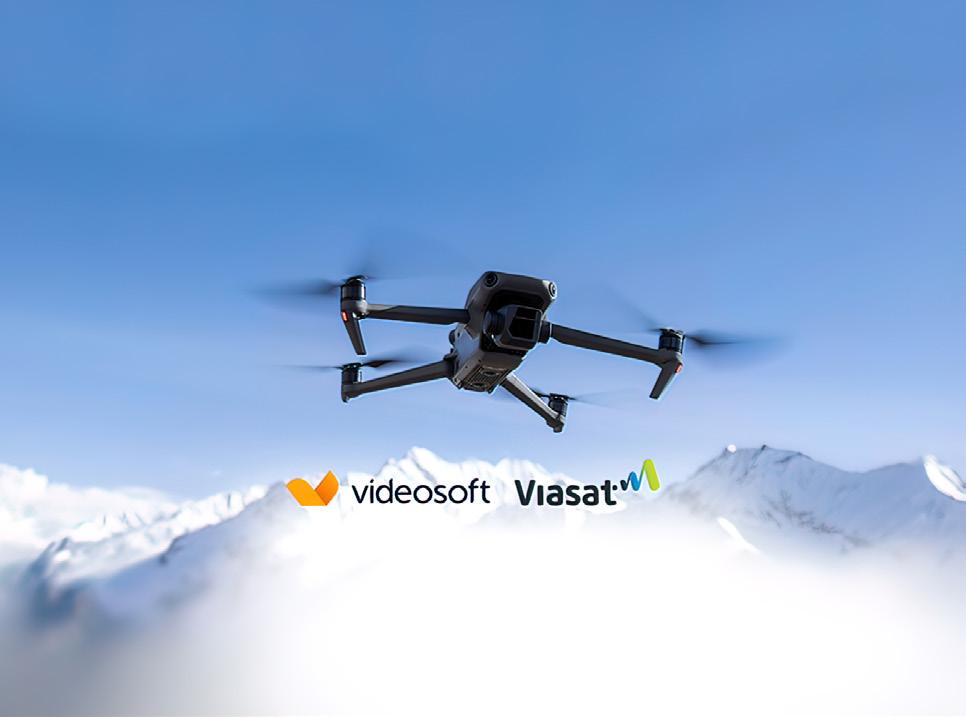

These terminals offer an always-available secure datalink between vehicles, remote operators and UAV Traffic Management (UTM) systems, thanks to Viasat’s resilient, global L-band satellite network.
This combination of lightweight hardware solutions with edge-compute capabilities is enabling faster integration of software, simplified installations, and reduced latency – thanks to the proximity of the software to the data connection, and enhanced endurance thanks to weight and power savings.
Joel Klooster, SVP Flight Safety and AAM at Viasat, said: “Our Velaris Partner Network continues to go from strength to strength, and this latest partnership builds on a years-long relationship with the team at Videosoft Global. This combination demonstrates our vision to include edge-compute capabilities inside the terminal hardware, which will provide a major advantage to software partners and end-users alike.”
Stewart McCone, chief executive officer at Videosoft Global, said: “It’s a privilege to join Viasat’s esteemed Velaris Partner Network, and to bring our robust, secure, and uninterrupted video streaming software to Viasat’s customers and partners. We know how critical our turn-key solutions are to realizing the future of airspace, and this will only be enhanced further by partnering with such industry leaders as Viasat. Together, we plan to continue to innovate and bring novel solutions to the aviation industry.”





We provide public safety and law enforcement accessories to agencies around the world. With a focus on continually expanding the number and types of products available, our parts and accessories include:
• Glass Cockpit Upgrades
• Rescue Hoists and Provisions
• Polycarbonate Windshields
• Fast Rope Insertion/Extraction System
• Lighting Kits
• Quick Mount Kits
• Health and Usage Monitoring (HUMS)
• High Visibility Windows
• Flight Data Monitoring
• Expanded Instrument Panels
• Autopilot
• Landing Gear and Steps
FOR MORE INFORMATION AND PRICING:
Visit aero-access.com email sales@aero-access.com or call 800-251-7094


Author: Chris Stonor

AUKteam has deployed the ULTRA Autonomous drone at the Rothera Research Station in Antarctica to conduct trials. The ULTRA Unmanned Aerial Vehicle (UAV) is designed for extreme environments, featuring fully autonomous capabilities, twin engines, and a 10-meter fixed-wing capable of carrying 100 kg of cargo or sensors up to 1000 km.
If successful, the ULTRA drone could significantly enhance the British Antarctic Survey’s (BAS) scientific capabilities, enabling more cost-effective and lower-carbon scientific research. The UAV's sophisticated autopilot system, Masterless, developed by Distributed Avionics, allows it to operate with minimal ground operator oversight.
The BAS aims to reach net zero by 2040, and the ULTRA drone aligns with their plans due to its lower carbon impact compared to traditional crewed aviation. The release mentions that using drones for airborne scientific surveys could dramatically increase flight time and geographic coverage while reducing CO2 emissions per flight hour by around 90%.





Dr. Tom Jordan, PhD, PG, a geophysicist from the British Antarctic Survey, expresses excitement about the potential of UAVs to collect diverse scientific data, which is crucial for understanding changes in the Antarctic ice sheet and their global impacts.
The Windracers ULTRA drone will be used in the testing phase for various purposes, including surveying environmentally sensitive areas, assessing the marine food chain (krill) using a camera, investigating tectonic structures with magnetic and gravity sensors, assessing glaciological structures using airborne radar, and testing an atmospheric turbulence probe for studying boundary layer processes.
The project is funded by Innovate UK’s Future Flight 3 Challenge and is part of the 'Protecting Environments with UAV Swarms' pilot program. It involves collaboration between Windracers, Distributed Avionics, Helix Geospace, Lancashire Fire and Rescue Service, National Environmental Research Council British Antarctic Survey, University of Bristol, and The University of Sheffield.
Source: SkeyDrone Press Release

Unifly, a Terra Drone Corporation group company and provider of unmanned aerial system traffic management (UTM) systems, and SkeyDrone, announced a significant upgrade to the Port of Antwerp-Bruges’ (PoAB) UTM, DronePortal, a cutting-edge UTM application developed by Unifly.
This upgrade enhances the efficiency of drone operations in the complex Port of Antwerp’s airspace and supports the expanded use of drone technology. Additionally, the upgraded services are now extended to include the Port of Bruges. This development is a crucial step in advancing the PoAB airspace towards U-space readiness.
Operational in the Antwerp Port area since midMarch 2021 and having processed over 5,000 flight authorizations, the PoAB DronePortal upgrade plays a pivotal role in the evolving U-space landscape.
The latest improvements include optimized automated approvals, enhanced integration support with drone operations, and user interface (UI)/user experience (UX) enhancements, all based on the most recent Unifly product version.
The Port of Antwerp-Bruges is expected to become the first official U-space airspace in Europe, marking a significant milestone in uncrewed aerial operations. The Port of AntwerpBruges has become a hub for drone activities, hosting the highest volume of drone flights in Belgium.

Beyond the D-Hive project that facilitates scalable beyond visual line of sight (BVLOS) drone flights, numerous drone operators fly within the same airspace for various purposes, further solidifying the port’s status as a key player in the drone ecosystem.
Erwin Verstraelen, chief digital information & innovation officer, Port of Antwerp-Bruges, said: “Embracing innovation is at the heart of our strategy, and this partnership with SkeyDrone and Unifly reaffirms our commitment to fostering a smart, connected, and future-ready port. Together, we’re shaping a new frontier in uncrewed aerial operations.”
According to Hendrik-Jan Van Der Gucht, managing director of SkeyDrone: “With this upgrade of the DronePortal, SkeyDrone is not only enhancing the user experience for drone operators but is also taking the next step towards U-space readiness, ensuring safe and seamless integration of unmanned aerial vehicles in the European airspace.”
Andres Van Swalm, CEO of Unifly, said: “We are excited about the growing number of drone operators gearing up for autonomous flights. The recent system upgrade, extending support to the Port of Bruges and advancing PoAB towards U-Space readiness, is a significant milestone. The PoAB stands as a global exemplar of how drones can be seamlessly integrated into non-segregated airspace.”

MightyFly unveils third generation aircraft, unlocks “unprecedented efficiencies for same-day deliveries” - EDITOR'S
Source: eVTOL Insights
Author: Chris Stonor

Cargo drone manufacturer, MightyFly, hosted an unveiling event of its new Cento autonomous third-generation aircraft to its investors, partners, potential customers and government representatives at the company’s HQ in San Leandro, CA, reports a press release. This included several stationary demonstrations.
The latest MF100 eVTOL can carry one hundred pounds of cargo for six hundred miles and has several new technical characteristics. They include:
• A larger cargo bay.
• A bi-wing design to enable a large trim of the aircraft centre of lift.
• The use of structural conductors to increase reliability and reduce weight.
• A composite structure to increase payload capacity by reducing structural weight.
• A modular design to optimise maintenance.
• The use of the canard as landing gear to lower drag and drive efficiency.
The new eVTOL also presents “improved operational efficiency through MightyFly’s

Autonomous Load Mastering System (ALMS) component, which will enable the aircraft to autonomously open and close its cargo bay door, receive and eject packages into and from the cargo bay opening, move and secure packages in the cargo bay via an internal positioning and locking system, and sense and compute weight and balance,” explains the release.
All of these tasks can be done autonomously, without requiring an operator to reposition the packages inside the aircraft. This helps to minimise the ground operation.
Manal Habib, co-Founder and CEO of MightyFly, commented, “We are very excited to unveil the 2024 Cento that couples innovation with efficiency in design, maintenance, and operation, bringing to the world the key to transform the expedited logistics market.” She continued, “MightyFly’s new eVTOL will revolutionise industries such as manufacturing, retail, and healthcare, and will transform life in rural and remote areas.”
The release continues, “The eVTOL is currently working with Agility Prime and Air Mobility Command in the development of the ALMS feature to solve the U.S. Air Force’s most pressing autonomous aerial logistics needs.”
And continues, “Additionally, the MightyFly’s third generation aircraft has been designed to accommodate a relatively large range of payloads’ centre of gravity, which allows for a high degree of variance in cargo contents, densities, constitutions, loading order, and tie-down positions. This design attribute is expected to be a key technology differentiator for the Cento platform and its utility to be extremely valuable and competitive in the market. “
The aircraft’s cargo bay is significantly larger than its second generation predecessor. This allows the delivery of larger packages and goods, including the traditional cooler boxes used to transport donor organs for transplantation and blood bags. It also benefits additional use cases and businesses in the industries of logistics, manufacturing, healthcare, pharmaceutical, retail, automotive, and oil and gas, as well as organisations performing humanitarian and disaster relief work, and government’s defence teams executing various logistics and resupply missions.
The event also included a presentation by one of MightyFly’s investors, Tim Draper, Founding
Partner of Draper Associates, who talked of the great potential of the third-generation Cento.
He remarked, “The vehicle you see today is a testimony of MightyFly’s talent, creativity, innovation, and decades of industry expertise. This technology will help save lives and solve painful logistics needs of businesses around the globe.”
MightyFly concluded production of this new aircraft in early January 2024 and will begin its qualification trials in February, which include a test plan previously followed for its predecessor aircraft.
In the fall of 2024, the company will publicly debut its autonomous cargo aircraft delivery flights in Michigan, demonstrating point-to-point autonomous delivery use cases to partners and potential customers.
MightyFly is also scheduled to demonstrate its autonomous loading, unloading, and balancing of packages capability to the U.S. Air Force in early 2025 to include additional Proof of Concept programs.

Sinopec and TotalEnergies
jointly
Source: SAF Investor
Author: Fayaz Hussain
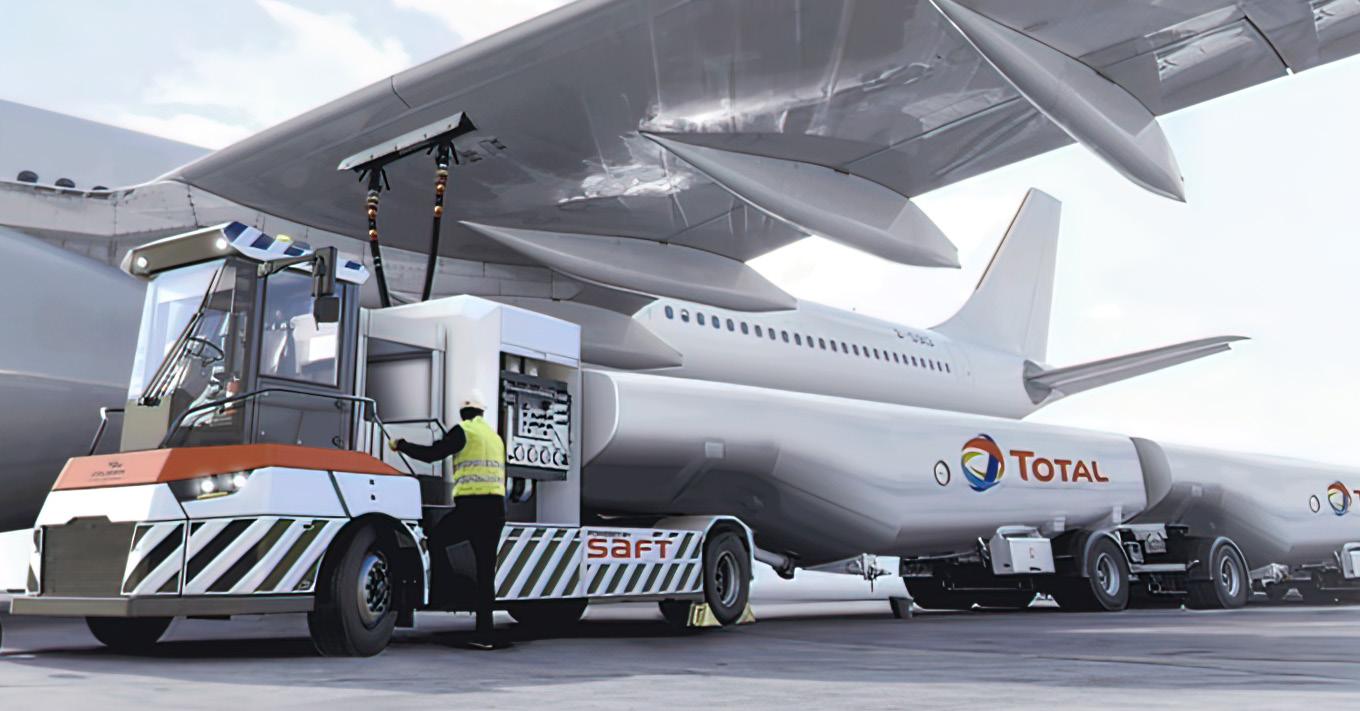
TotalEnergies announced that it has signed China Petroleum and Chemical Corporation (Sinopec) have signed an agreement to develop a sustainable aviation fuel (SAF) production unit at a Sinopec’s refinery in China.
“We are very pleased to collaborate with Sinopec, a major player in the global refining industry, to produce SAF and structure a SAF production chain in China.
The development of SAF is at the heart of our company’s transition strategy, as we strive to meet the aviation industry’s demand to reduce its carbon footprint. TotalEnergies has set itself a target of 1.5m tons of annual SAF production by 2030,” Patrick Pouyanné, chairman and CEO, TotalEnergies.
The planned unit, jointly owned by Sinopec and TotalEnergies, will have the capacity to

produce 230,000 tons of SAF per year, and will process local waste or residues from the circular economy (cooking oils and animal fats).
The unit will likely use SRJET technology, developed by Sinopec to produce SAF.
TotalEnergies, already one of Europe’s leading SAF producers, will bring its experience and expertise in the technical, operational and distribution fields.
“This milestone collaboration with TotalEnergies is in line with our strategy in the development of low carbon solutions for China and the world. Sinopec is committed to providing green and low-carbon energy solutions while improving quality and efficiency of its asset portfolio,” said Yongsheng Ma, chairman, Sinopec.

Source: SAF Investor
Author: Fayaz Hussain

Greek airline AEGEAN announced that it is expanding its sustainable aviation fuel (SAF) program across key European airports in partnership with with Shell & MOH Aviation.
The move will help AEGEAN secure SAF supplies at Stockholm Arlanda and London Heathrow airports.
The airline aims to gradually roll out the program across its network wherever SAF becomes available.
“Our collaboration with Shell and MOH Aviation allows us to expand our SAF program to international airports, reducing our environmental impact,” said Dimitris Gerogiannis, CEO, AEGEAN.
“While supply limitations pose a challenge,

partnerships like this keep us optimistic about expanding operations while lowering CO2 emissions.”
Meanwhile, Stamatis Petsis, CEO, Shell & MOH Aviation, said: “We’re proud to cooperate with AEGEAN in supplying SAF to major airports. This initiative reflects AEGEAN’s commitment to sustainability, and we hope it inspires others in the Greek aviation industry.”
In 2021, AEGEAN became the first Greek airline to use SAF on a flight. Since July 2022, all departing aircraft from Thessaloniki Makedonia Airport, their second-largest hub, utilise SAF blends.
Additionally, the airline also secured SAF supplies for Oslo Gardermoen Airport in late 2023.
Source: SAF Investor
Author: Fayaz Hussain

DHL Express announced that it has signed a long-term agreement with Japan’s SCREEN Semiconductor Solutions Co., Ltd. for GoGreen Plus service to reduce emissions through the use of sustainable aviation fuel (SAF).
“We are actively working to combat climate change in our supply chain with the goal of becoming carbon neutral by 2050 in order to contribute to a more sustainable society. The contract with DHL as an important milestone in our efforts to reduce greenhouse gas emissions, especially since nearly 80% of our total sales are from our clients overseas,” said Masato Goto, president, SCREEN Semiconductor Solutions Co.
GoGreen Plus is DHL Express’ international shipping service that insets the carbon emissions through the use of SAF.





With the signing of this agreement, SCREEN Semiconductor Solutions aims to reduce 100% of the CO2 emissions associated with their use of international express shipment which they use for shipping of small parts including maintenance parts.
“For many of our Japanese customers, many of their overseas business partners and customers expect our customers to do more to combat climate change. We are delighted that our GoGreen Plus service will be fully leveraged by SCREEN Semiconductor Solutions to bring down their Scope 3 emissions,” said Tony Khan, president, DHL Express Japan.
Currently, about 1,500 companies in Japan have adopted the DHL Express GoGreen Plus service for their international shipments to reduce their emissions.
















Source: Volatus Infrastructure & Energy Solutions Press Release

Volatus Infrastructure & Energy Solutions has partnered with ScoutIt to utilize electric vehicle (EV) batteries that can no longer be used in vehicles but still have life left in them.
VI&E Solutions will recycle the EV batteries by installing them in their new “battery wall” product line that will create an off-grid charging solution.
“The proliferation of electric transportation brings many new challenges. Being able to work with a company like ScoutIt to ensure continued life for EV batteries and develop new power storage technology is a blessing. Their understanding of battery lifecycles is second to none,” said Grant Fisk, VI&E Solutions cofounder and COO.
“Partnering with VI&E Solutions is a key step to ensure that eVTOL manufacturers, and

the whole industry in general, have a clear strategy on how to handle batteries and what to do with them once they’re exhausted and can’t propel the aircraft. There’s so much potential in eVTOL batteries and we will help all the players create sustainable solutions and ensure a true eVTOL battery circular economy,” said Davide Giacobbe, Scoutit founder and CEO.
The mission at ScoutIt is to enable a true circular battery economy. No battery should be prematurely recycled or incorrectly disposed of. ScoutIt empowers each company with the tools to achieve exactly this: correctly manage and potentially profit from Endof-Life batteries and comply with disposal regulations. They do so by helping them efficiently track and manage EOL batteries and evaluate disposal alternatives and procedures.
Source: SAF Investor
Author: Fayaz Hussain

LanzaJet announced that it has opened the world’s first ethanol to sustainable aviation fuel (SAF) production facility ‘LanzaJet Freedom Pines Fuels’ in Soperton, Georgia with the nameplate production capacity of 10m gallons per annum.
“LanzaJet Freedom Pines Fuels is proof of the energy transition accelerating in real time,” said Jennifer Holmgren, CEO, LanzaTech. “We are demonstrating the ability to establish secure supply chains domestically, create new jobs locally, and produce sustainable aviation fuel globally. This historic facility is an important pillar of a growing SAF economy in the United States and is a significant decarbonisation milestone in the world.”
The SAF produced at the Freedom Pines Fuels facility will be used immediately as drop-in fuel for existing aircraft in an aviation industry.
LanaJet developed its ethanol-to-SAF technology in 2010 with the collaboration of the Pacific Northwest National Laboratory (PNNL).
“The Biden-Harris Administration is committed to harnessing the full potential of SAF as we

continue to build a strong economy that is sustainable, resilient, competitive, and keeps rural places thriving,” said Thomas Vilsack, US agriculture secretary.
“As we transition to SAF, this will not only create new climate smart commodity markets for American producers, but it will also help American companies such as LanzaJet corner the market of a valuable, emerging industry, while revitalising rural communities like Soperton with agriculture front and center in the effort. LanzaJet’s facility will help accelerate the SAF industry and provide new economic opportunities for producers for a more sustainable future.”
The opening ceremony of Freedom Pines Fuels was also attended featured LanzaJet shareholders International Airlines Group (IAG), LanzaTech, Mitsui & Co., Ltd., Shell, and Suncor Energy and investors such as the Microsoft Climate Innovation Fund, Breakthrough Energy, British Airways, and All Nippon Airways (ANA).
LanzaJet Freedom Pines Fuels is fully funded and has committed offtake agreements for all fuel produced in the next 10 years.




